One thing many aquarists focus on when setting up an aquarium and picking fish to stock it with is color. One or multiple colorful fish species can really brighten up a tank and make it become the centerpiece of a room.
A wide range of vibrant freshwater fish species in the aquarium industry have beautiful colors, but which are the absolute brightest?
Keep reading to find out some of the most colorful freshwater fish and how to keep them at their brightest in your own aquarium setting!
How to make your fish more colorful
Believe it or not, there are a few tricks to making your fish appear more colorful.
First and foremost, this begins with a healthy fish and a healthy aquarium system. Here are a few other ways to get your fish to look their best.
Healthy fish
From the start, you want to pick healthy fish. When choosing the fish to buy, you should look for signs of disease, mutations, or behavioral downfalls.
You want a strong, active fish that will be able to quickly bounce back to full life once introduced into your freshwater home aquarium.
Healthy aquarium
Next, you want to make sure that you’re introducing your fish into an ideal setting. The tank should always be cycled with adequate filtration and water movement.
A planted aquarium offers more natural benefits, though it is unnecessary as long as water changes are regular.
On top of the overall health of the aquarium, you may make aesthetic choices that heighten the color of your fish.
Substrate
Substrate can play a major role in choosing bottom-dwelling fish or even different aquatic plant species. It can also be used to create contrast between the tank’s inhabitants and their environment.
In general, a darker substrate will cause fish and invertebrates to be more visible. This is especially true in shrimp tanks, where color close to the bottom of the aquarium really pops against a dark backdrop.
Backdrop
You will also want to think about the backdrop of the aquarium. Many hobbyists choose to keep live aquarium plants due to their many benefits, but backdrops can also be used to bring fish forward in the aquarium landscape.
These plants don’t need to be anything out of the ordinary. Even the simplest, low-light species can help bring an extra dynamic to the aquarium to make your fish shine more.
If you still don’t want lots of plants, you can also choose an external background. These can be purchased at your local pet or fish store, or DIY’d with some construction paper.
Dark colors will definitely help make bright colors stand out!
Lighting
Lighting can make a world of difference in your aquarium. Not only will brightness affect how you see your fish, but the type of lighting will have a massive influence on how its array of colors is reflected.
In our opinion, LED lighting gives the best color to fish, but this can change between setups.
Tank mates
Lastly, tank mate stocking can determine the overall aesthetic of the aquarium.
While there are plenty of colorful community fish, too much color can be confusing. Instead, you will want to ration out the color to the most eye-catching species of the tank.
Generally, most hobbyists try to keep a larger centerpiece species accompanied by smaller, less colorful fish. Of course, there are ways to work with color all over the aquarium!
The most colorful fish for your aquarium
The secret to having a beautiful tank is color and movement. You want fish that catch the eye and are fascinating to look at.
More importantly, though, you want contrast. This way, vivid colors stand out even more. Contrast can be achieved by mixing ornate fish with less colorful species of fish and picking plants and decorations that compliment your selection.
Here are some of the best fish to achieve that dazzling burst of color you’ve been looking for in your aquarium!
Rainbowfish (Melanotaeniidae family)
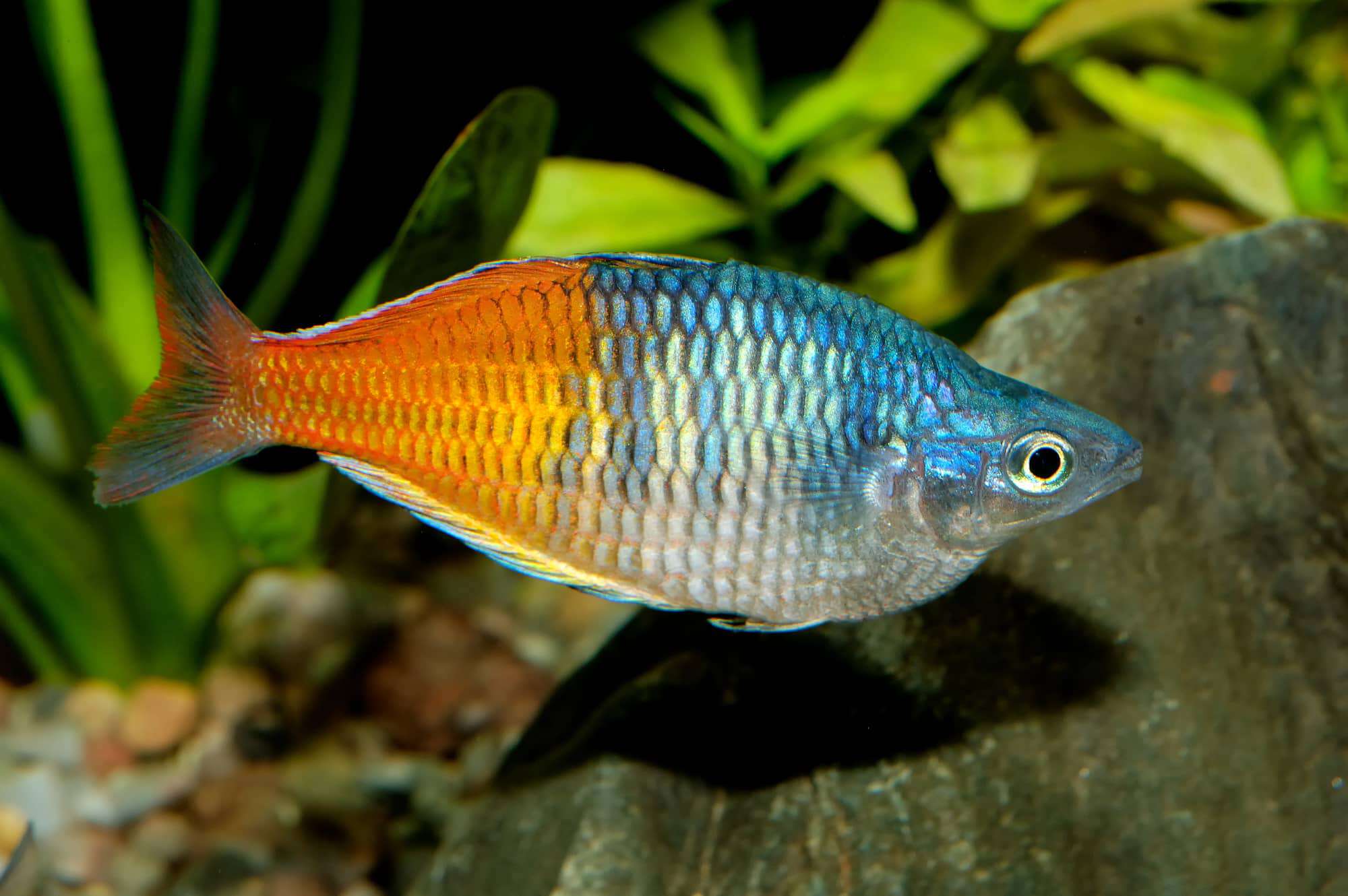
A fish named after its colors deserves a place on this list. Rainbowfish are very colorful freshwater fish that can be kept with a wide variety of tank mates.
Most of the members of this hardy fish family are relatively small, though they need to be kept in schools. This means that most species of rainbowfish need a minimum tank size of 40 gallons (151.4 L).
The most popular rainbowfish available are Boesemani rainbowfish (Melanotaenia boesemani), Australian rainbowfish (Melanotaenia fluviatilis), red rainbowfish (Glossolepis incisus), and threadfin rainbowfish (Iriatherina werneri).
Tetras
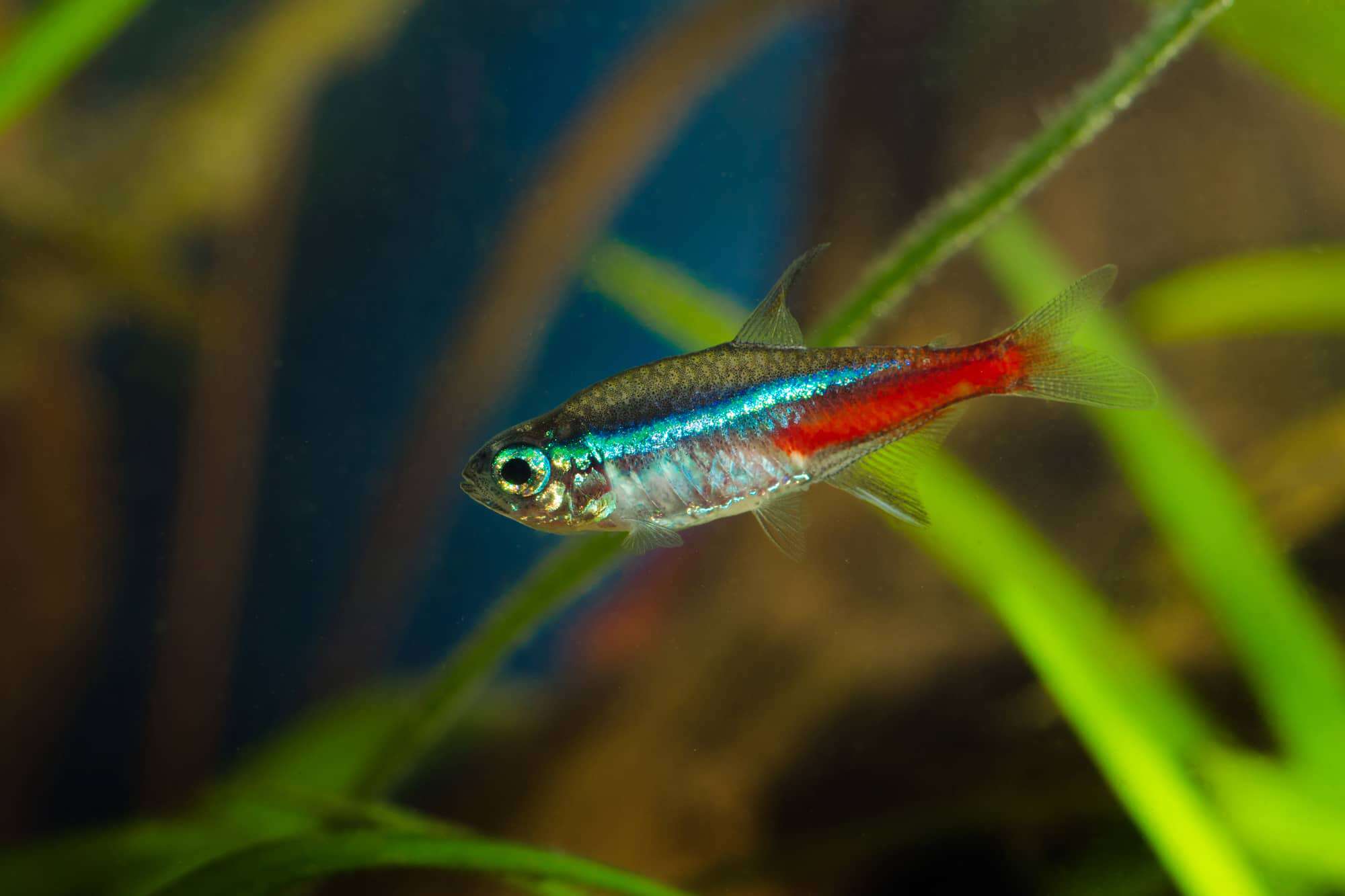
Not only are tetras easy to keep, but they’re also incredibly colorful freshwater fish!
These peaceful community fish are schooling fish and need to be kept in large groups for security. Smaller species can be kept in 10 gallons of water (37.9 L), but larger schools and species will do much better when they have room to swim.
Otherwise, they don’t require any special level of care. As most of these fish originate from the Amazon River basin, they will appreciate tannin-stained blackwater conditions with soft and acidic water parameters.
Here are some of the most colorful tetra species available:
- Neon tetra (Paracheirodon innesi)
- Cardinal tetra (Paracheirodon axelrodi)
- Emperor tetra (Nematobrycon palmeri)
- Congo tetra (Phenacogrammus interruptus)
- Ember tetra (Hyphessobrycon amandae)
- Rummynose tetra (Hemigrammus rhodostomus)
- Bleeding heart tetra (Hyphessobrycon erythrostigma)
Some fish on this list might be more challenging to keep than others and might have a different required tank size. Always make sure to research the exact care needs of the fish you plan on getting before taking them home!
Cichlids
There are many different cichlids with basically every color and pattern imaginable. A few especially catch the eye, though.
This includes flowerhorns, discus, dwarf cichlids, and a few other species in the family.
Flowerhorn
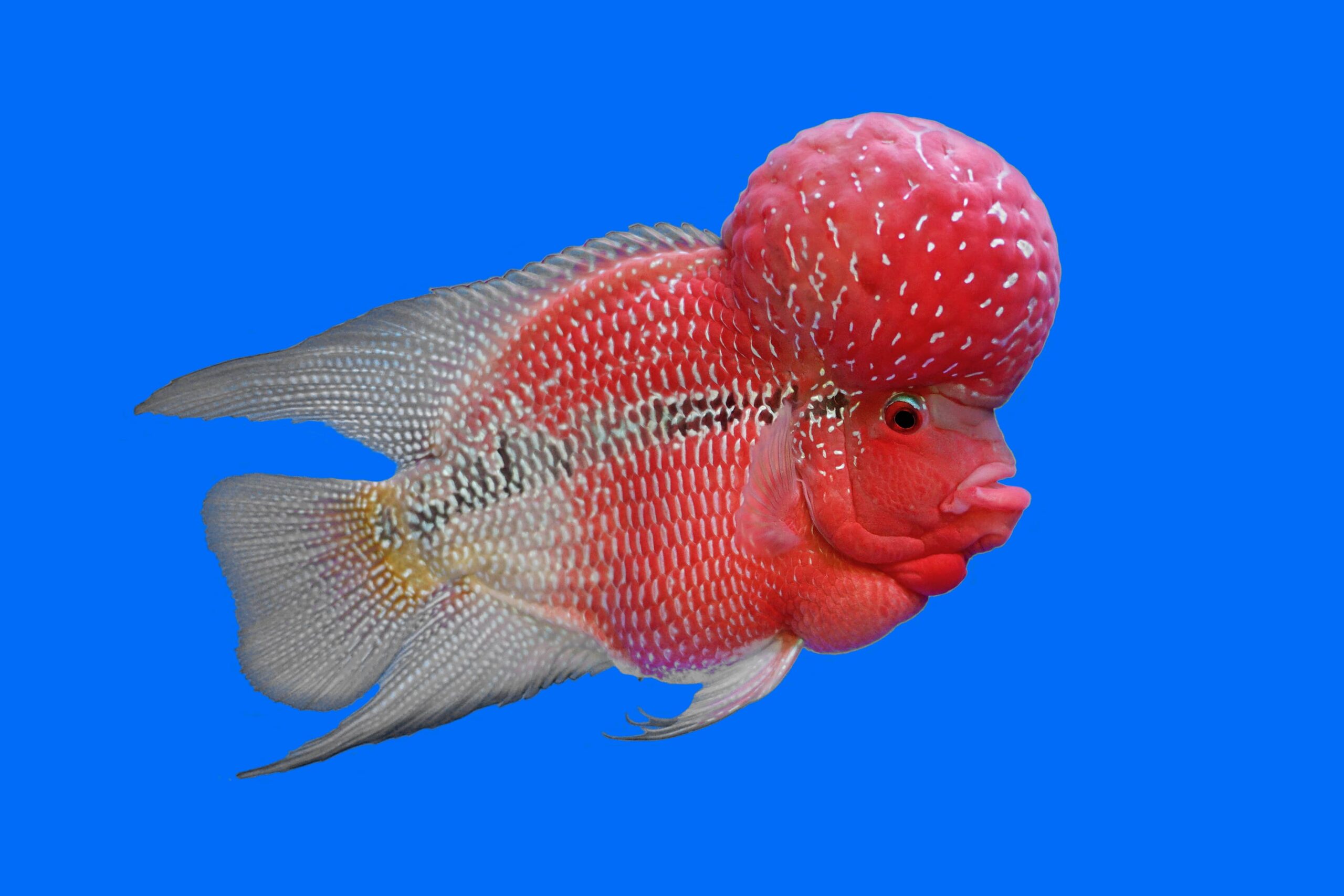
The flowerhorn is a hybrid fish with an impressive large nuchal hump on its head and even more vibrant colors. Not to mention, these fish are also full of personality!
One flowerhorn cichlid needs at least 55 gallons (208.2) with enough space at the top to allow for their hump. For the same reason, they do best with minimal decorations and good water quality.
Flowerhorn cichlids were created for their beauty. This means that you can pay as much as you want for your ideal fish. The choices are nearly endless!
Discus (Symphysodon spp.)
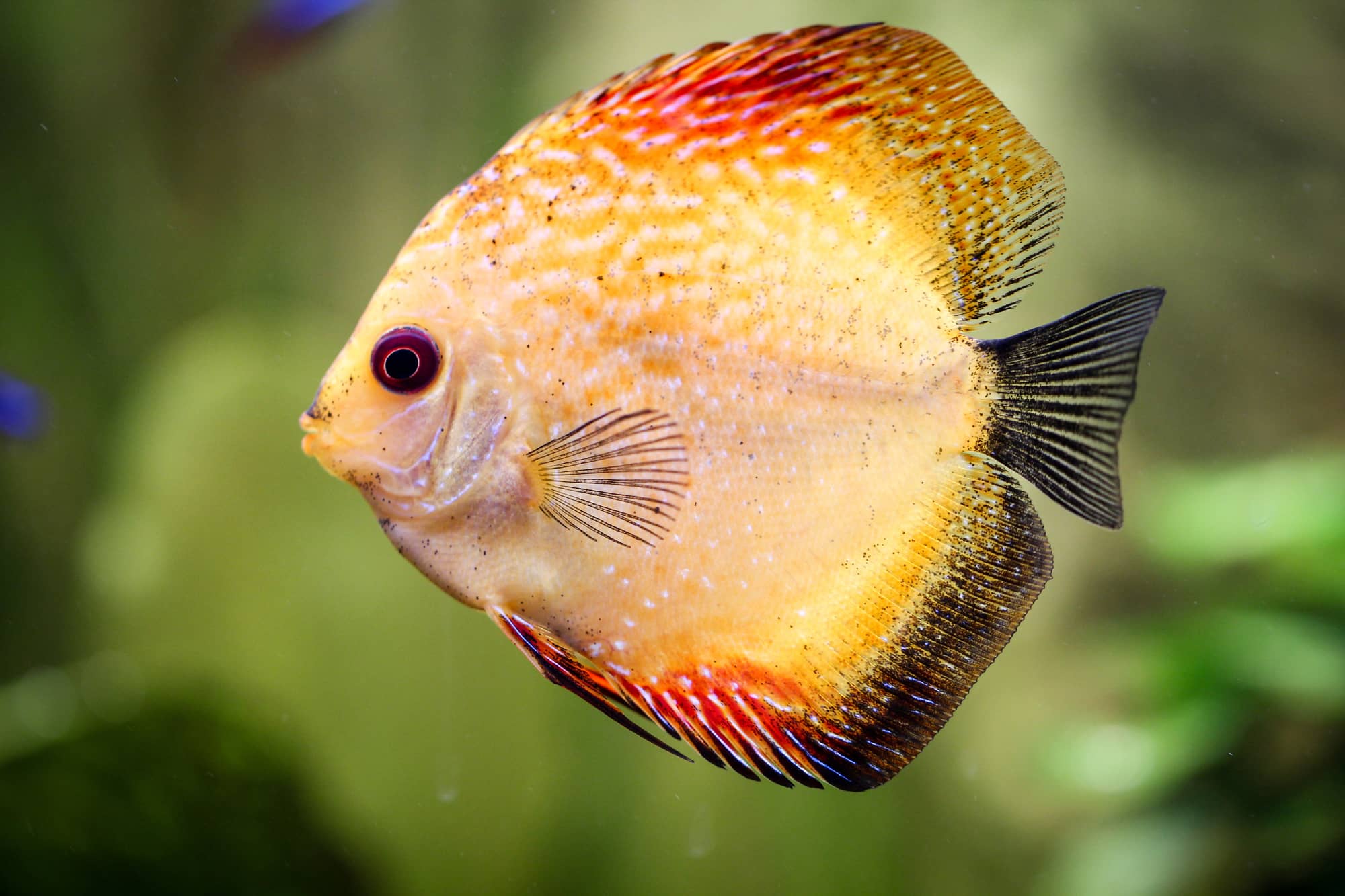
Freshwater discus are probably the most colorful fish of the freshwater world but are also considered a high-maintenance fish and one of the most difficult to keep.
These incredible fish come in electric blues, reds, oranges, and paler tones and need top water quality with daily water changes. Discus need to be kept in groups, and their minimum tank size recommended is 75 gallons (283.9 L) tank.
Discus also do best at tropical temperatures between 85-86° F (29.4-30.0° C), which is different from what most beginner hobbyists are used to dealing with.
Blue ram cichlid (Mikrogeophagus ramirezi)
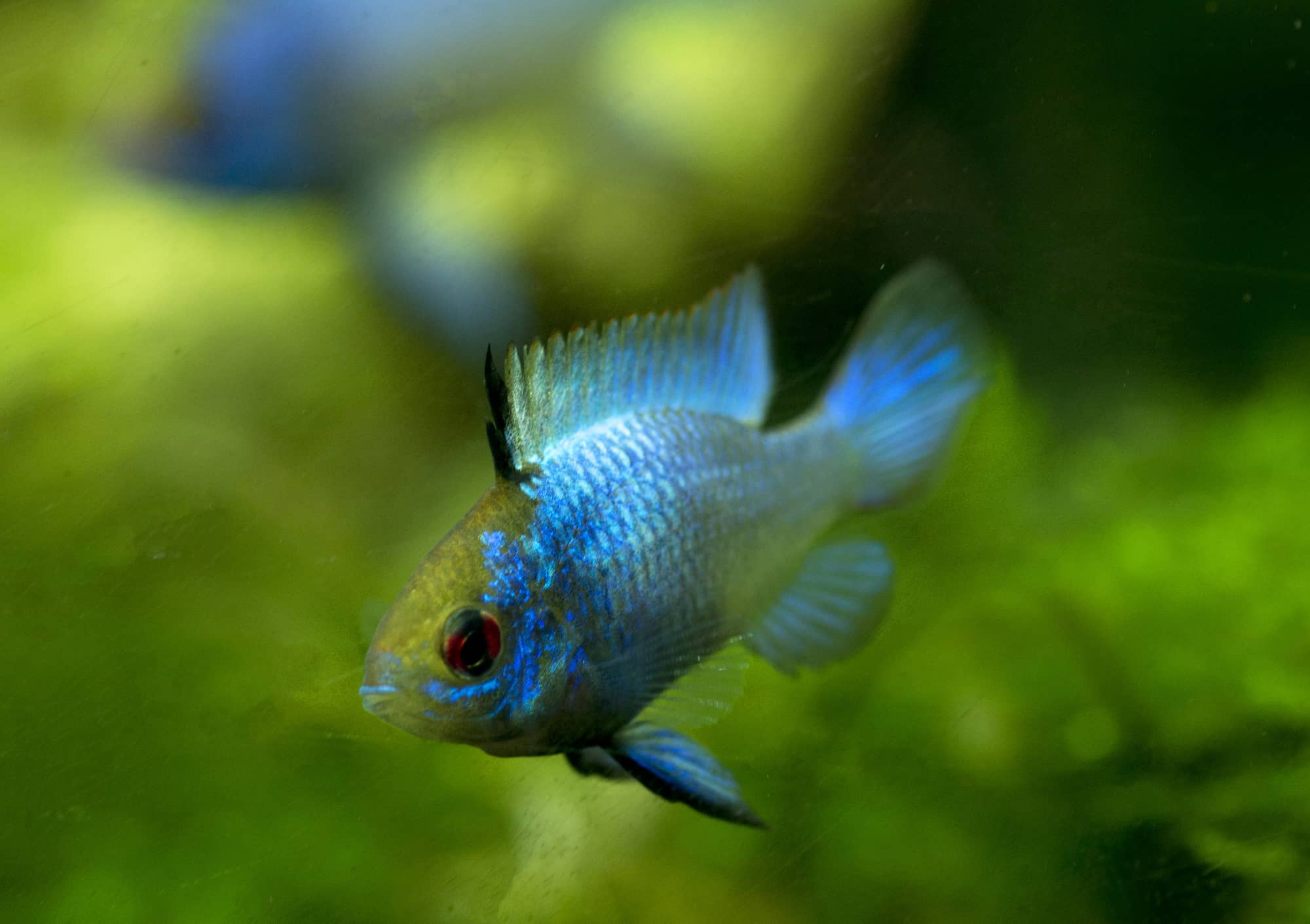
Another favorite fish is the blue ram cichlid. These relatively peaceful South American cichlids feature yellow and neon blue coloration on both the males and the females.
Though not the easiest aquarium fish species and not suitable for just any community tank, ram cichlids make an excellent choice for peaceful soft-water setups. While generally easy to keep, they can be a little sensitive to water parameters.
A pair of blue ram cichlids will need a 20 gallon (75.7 L) long aquarium. Keep in mind that the tank should always be fully cycled as all dwarf cichlids are sensitive to bad water quality.
They have a relatively peaceful nature but can become more territorial fish when spawning, though usually not as aggressive as other cichlid species.
Cockatoo dwarf cichlid (Apistogramma cacatuoides)
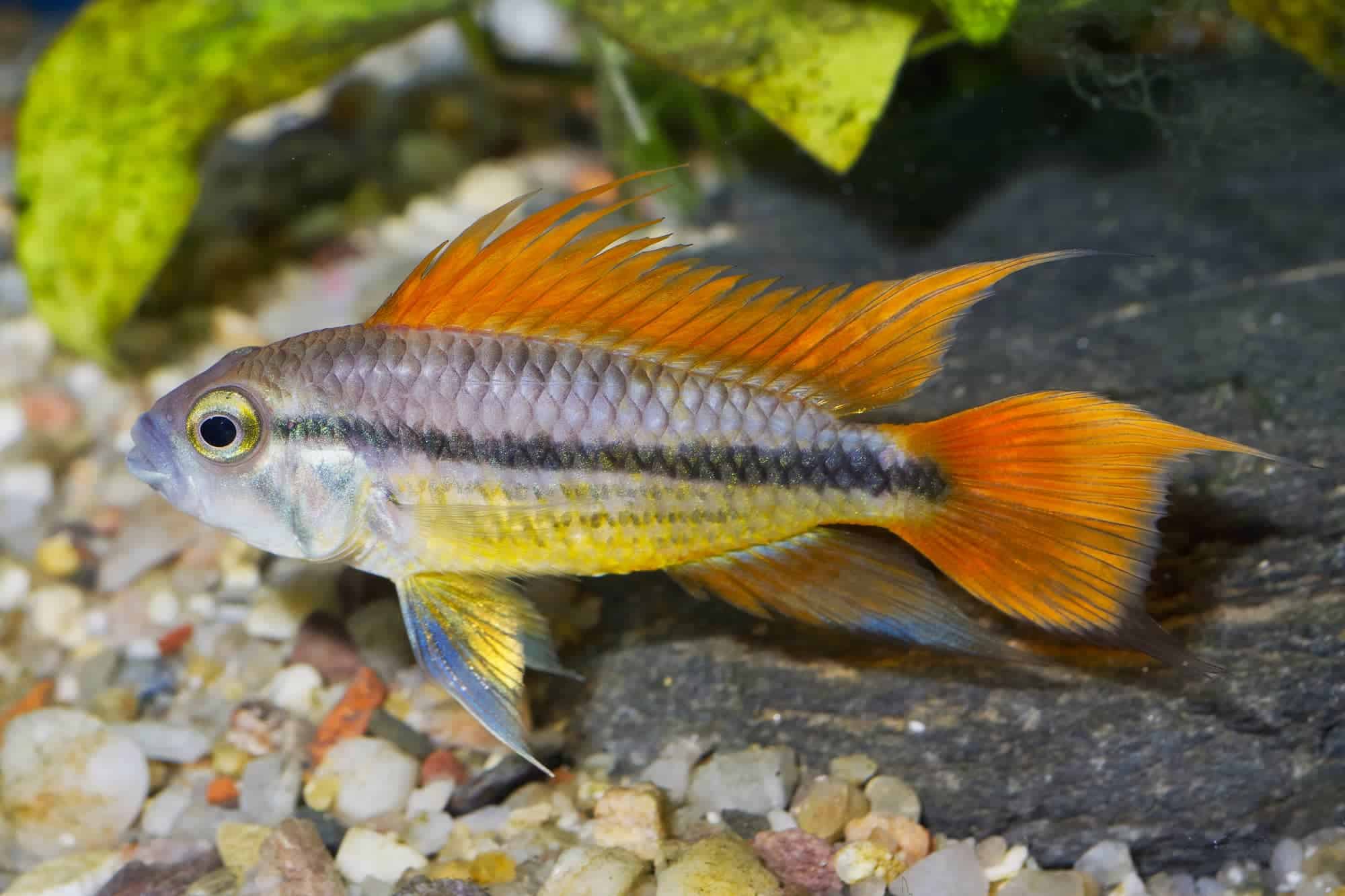
Another popular dwarf cichlid is the cockatoo dwarf cichlid, usually referred to by its scientific name. The male fish have brown bodies with attractive fiery red fins.
These fish are peaceful when they’re not spawning and can be kept with other colorful tank mates with special consideration.
A pair of cockatoos will need a 20 gallon (75.7 L) long aquarium. The water should be soft and acidic, with plenty of available caves and crevices.
Jewel cichlid (Hemichromis bimaculatus)
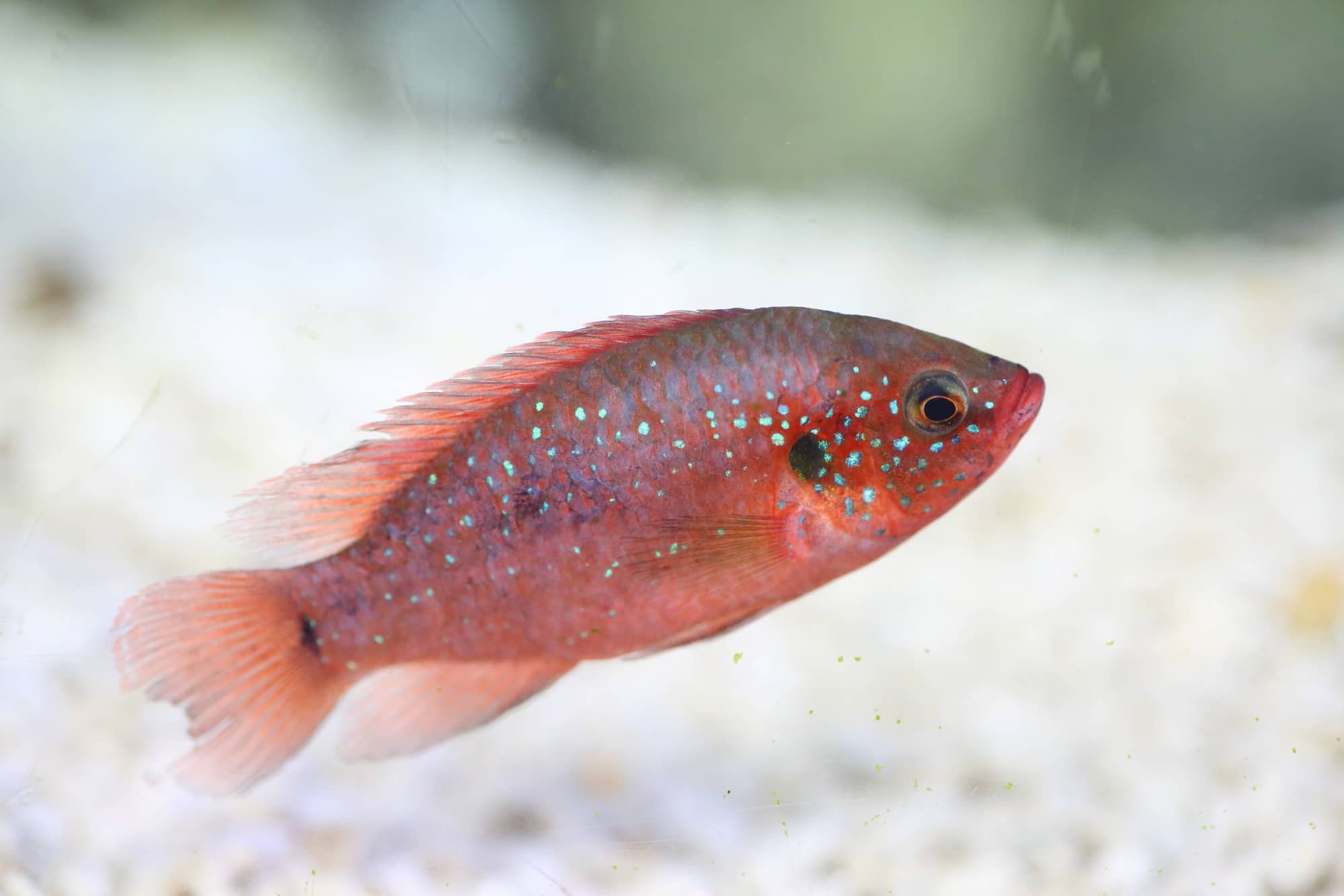
The jewel cichlid can become the gem of the tank. These beautiful fish are bright red with iridescent blue dots all along their bodies.
Jewel cichlids are a larger species of cichlid and need a minimum tank size of 55 gallons (208.2 L). As a cichlid, these fish are aggressive and do best when kept as formed pairs or in cichlid community tanks.
Interestingly, these fish pair for life, making for very interesting breeding behaviors.
Oscar cichlid (Astronotus ocellatus)

Oscars are known as the puppies of the aquarium. These fish are full of character and have some impressive colors as well.
The typical oscar will have a dark brown body with fiery red leopard-like markings. However, there is another variation of the oscar, called the albino oscar.
These fish are identical to regular oscars but have a white base coloring with overlaying orange markings. The name ‘albino oscar’ is a bit of a misnomer, though.
Most white oscars available do not truly have albinism, a genetic occurrence where pigment is absent from areas where melanin is present.
A true albino oscar will have pinkish-red eyes and pinkish markings. They are relatively rare to find for sale and can have shorter lives than regular oscars.
Instead, these white oscars are something called lutino. These fish do not have pink eyes and keep the orange to their markings. They may sometimes be confused with the lemon oscar, another colorful variation of these fish.
You can read all about the differences between different oscars here!
It is important to note that oscars of any color are huge fish. At least 55 gallons (208.2 L) is recommended for a single fish without any tank mates. Their personality can quickly fill this space, though.
Guppies
Guppies are often overlooked as serious fish because they are a favorite pet fish choice for beginners. In fact, these are some of the most colorful freshwater fish available in the hobby!
When discussing colorful guppies, there are two main species to choose from: fancy guppies (Poecilia reticulata) and Endlers guppies (Poecilia wingei). Endlers tend to migrate to the top of the water column in a very large healthy tank.
Male guppies are usually the most colorful, with bodies and fins of all different color combinations. Though females are generally duller in color, they can still bring color that other species can’t and pass on those genes to their offspring!
It’s not just their color that makes guppies such a great choice to brighten up an aquarium: they are also very active and display interesting behavior towards each other. Because of this, they need a minimum tank size of at least 10 gallons (37.9 L) with close population control.
Due to their popularity, guppies are often victims of improper care. Be sure to look at this guppy care sheet if you want to keep them correctly and see their best colors.
Killifish
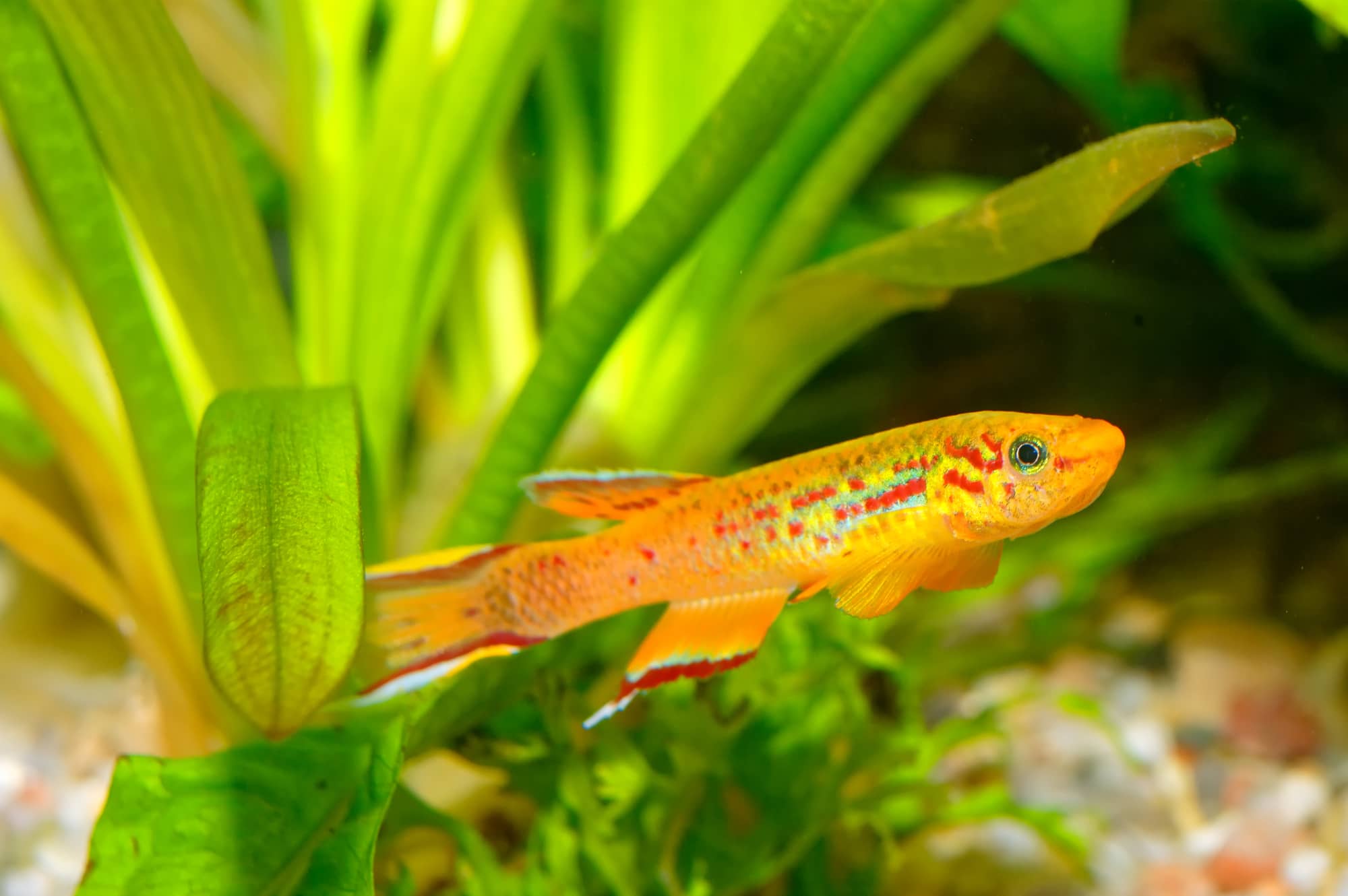
Killifish are often overlooked because they’re not as widely available as other species and can be more expensive. Still, they come in a variety of colors and are pretty easy to keep. These fish also have short life spans, so that can be unappealing.
Otherwise, they don’t require much space as they don’t school. Killifish can bring a unique splash of color and appearance to the freshwater aquarium; some species can even live in brackish conditions!
Here are some of the most common varieties of killifish:
- Golden panchax (Aphyosemion australe)
- Clown killifish/banded panchax (Epiplatys annulatus)
- Golden wonder killifish/striped panchax (Aplocheilus lineatus)
- Redtail notho (Nothobranchius guentheri)
- Bluefin notho (Nothobranchius rachovii)
Celestial pearl danio (Danio margaritatus)
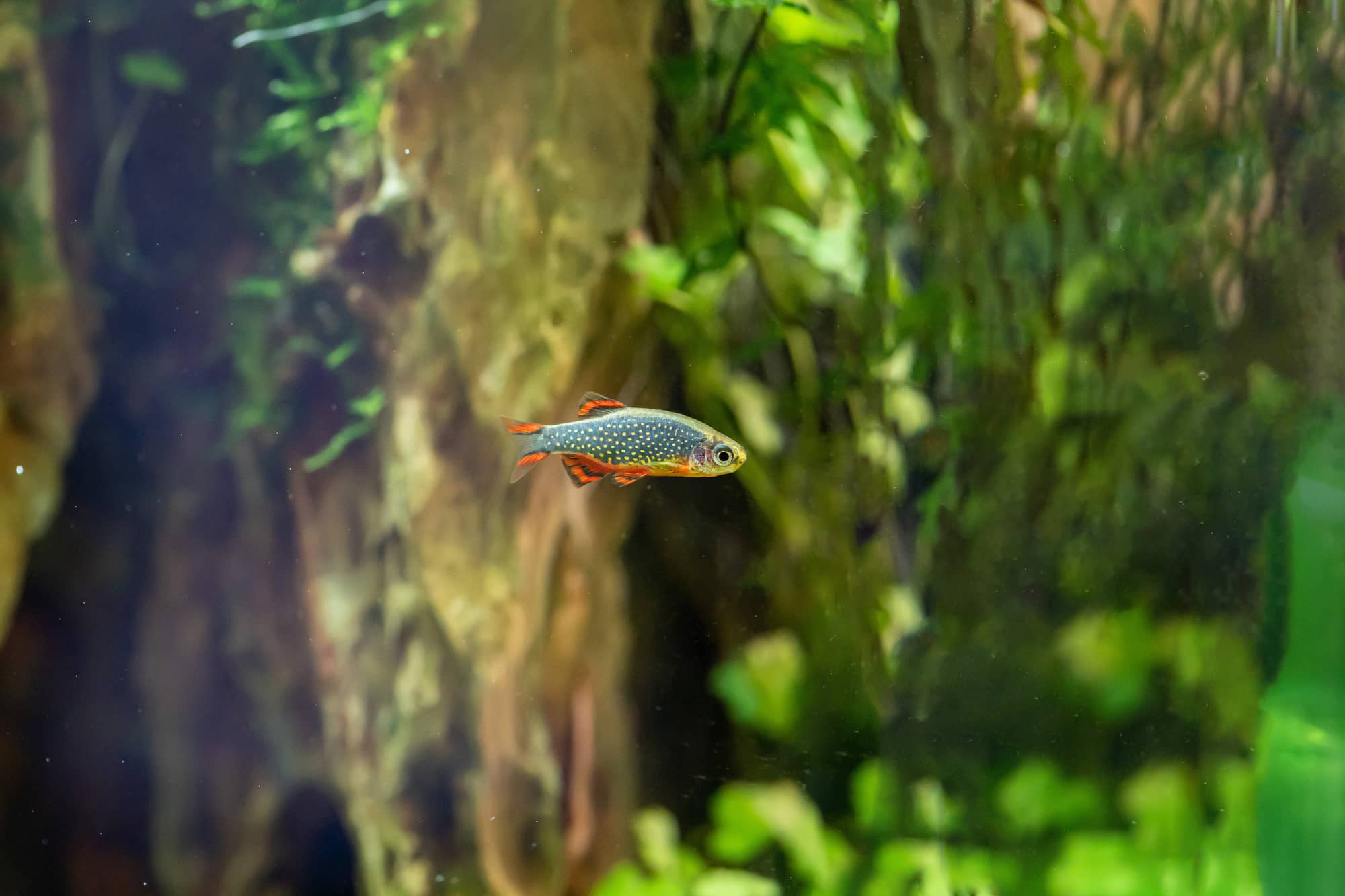
Another underrated fish is the celestial pearl danio. For the same reasons of expense and availability, these fish aren’t as commonly seen in the home aquarium as other tropical species.
These fish stay very small, under 1.5 inches (3.8 cm), but have a whole galaxy on their trout-like bodies. They are colorful schooling fish and require at least a 10-gallon tank (37.9 L) with stable parameters.
These fish are a little more difficult to keep than your average tropical community tank fish. Most individuals are wild-caught due to the difficulty associated with captive breeding, which can cause some problems while adapting.
Celestial pearl danios are a personal favorite, though, and really don’t compare with any other fish.
Cherry barb (Puntius titteya)
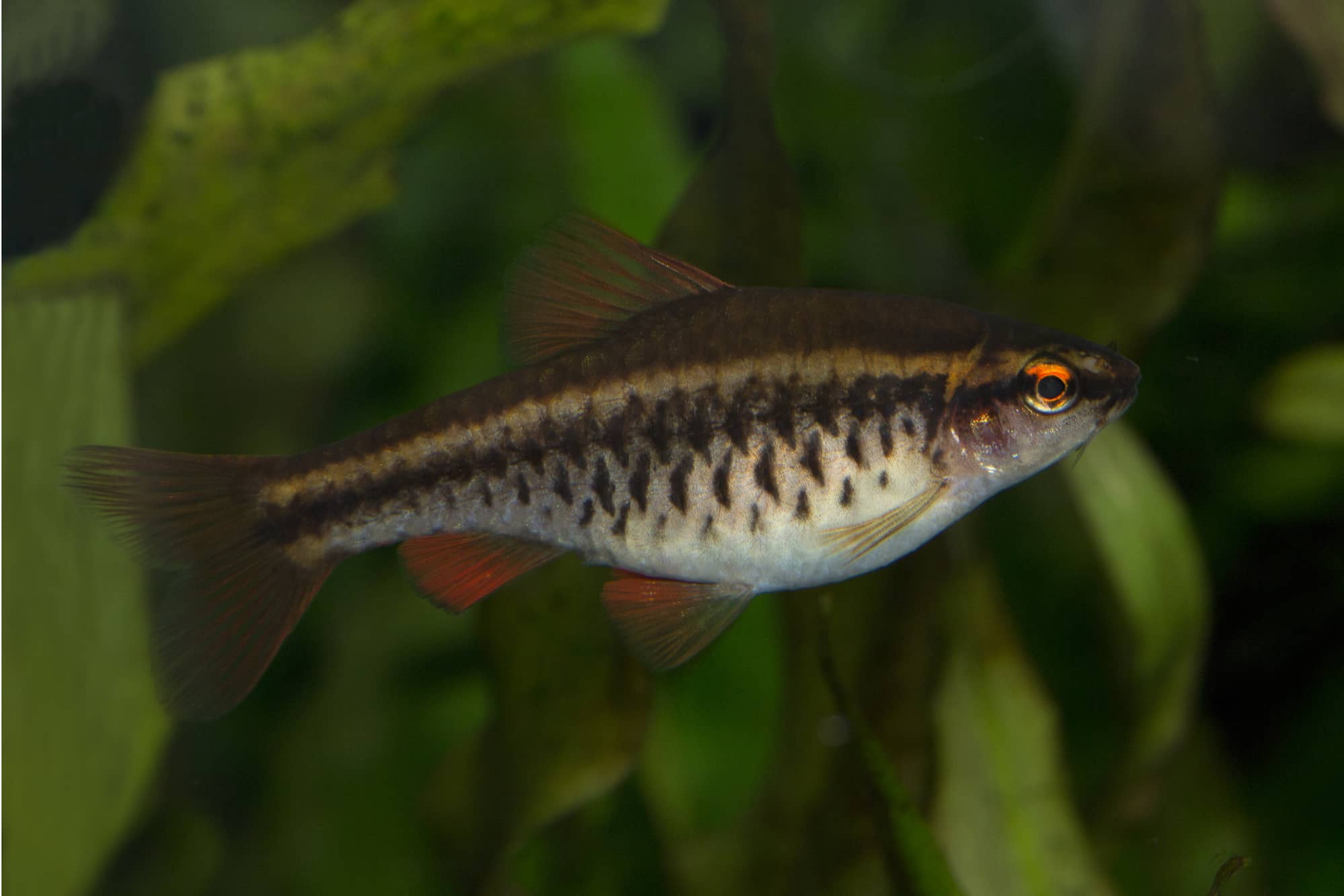
Though widely available, the cherry barb isn’t included in livestock lists nearly as much as it should be.
These yellow and copper-colored peaceful schooling fish are much more exciting to watch than many other fish. They can be shy at first but will quickly take up any space that they can with their loose schooling formations.
On top of that, they stay pretty small and can fit into an assortment of tank setups. The minimum tank size they need is 30 gallons (113.6 L) due to their activity level.
Gourami (Osphronemidae family)
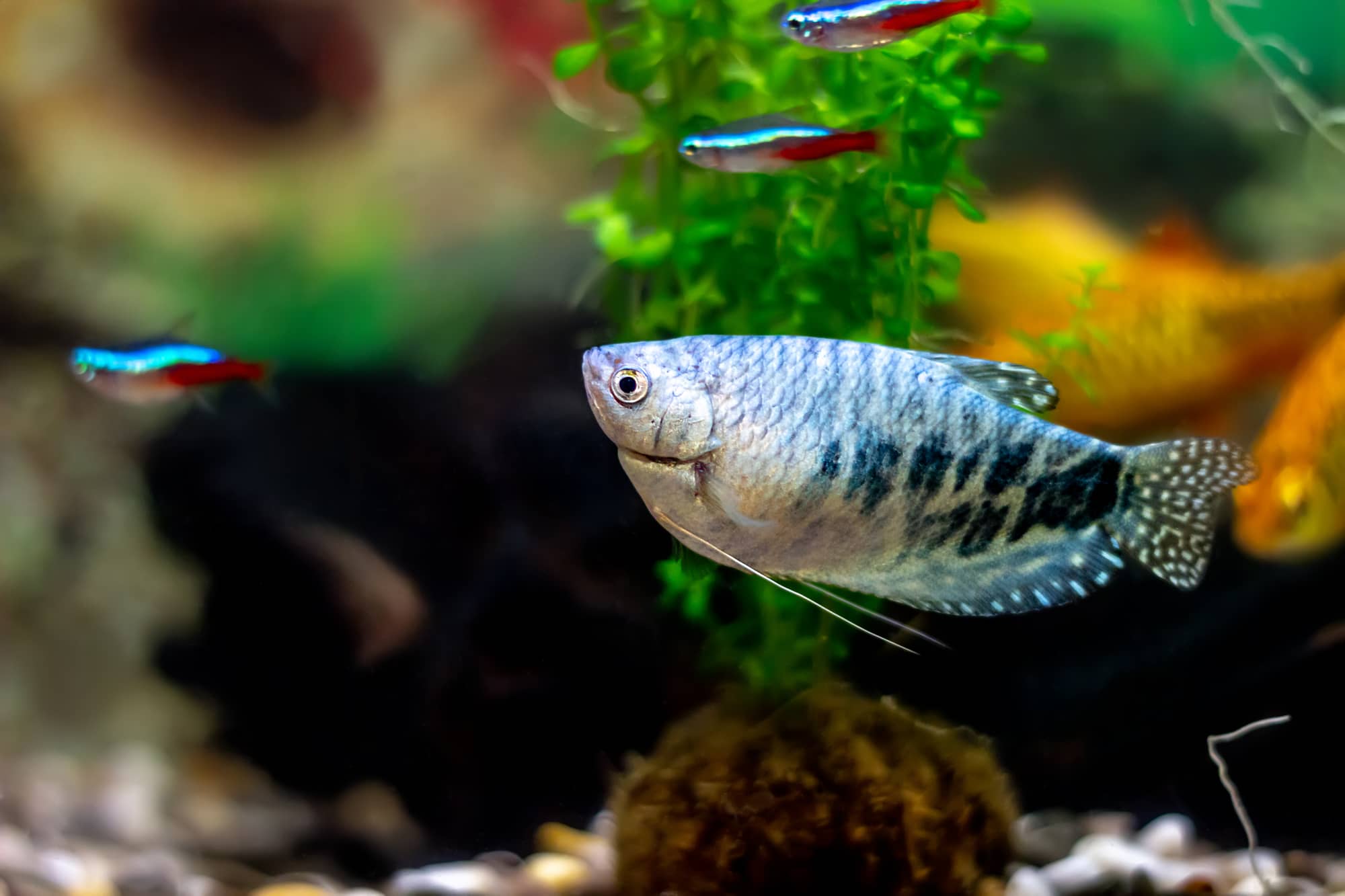
Even more available than cherry barbs are gourami fish, both dwarf, and full-size options.
Almost all gourami species are very brightly colored, making them a perfect choice for anyone setting up a peaceful community aquarium and looking for that one centerpiece fish.
The most common gourami species in the aquarium trade is probably the dwarf gourami (Trichogaster lalius) due to their starburst colors.
Their neon blue and orange combination makes the dwarf gourami a real eye-catcher. These fish also stay relatively small and do well in peaceful community tank setups above 10 gallons (37.9 L) as long as they’re stocked accordingly and with plenty of plants.
Even though this species is widely regarded as a peaceful fish, they have aggressive tendencies comparable to bettas (Betta splendens).
If you’re a fan of gouramis but are looking for something a little less common than the dwarf gourami, there’s also the bright blue three spot gourami (Trichopodus trichopterus), the lovely yellow honey gourami (Trichogaster chuna), or even the spectacularly striped licorice gourami (Parosphromenus deissneri).
As these species are larger, they need a larger tank size of at least 40 gallons (151.4 L).
Betta fish (Betta splendens)
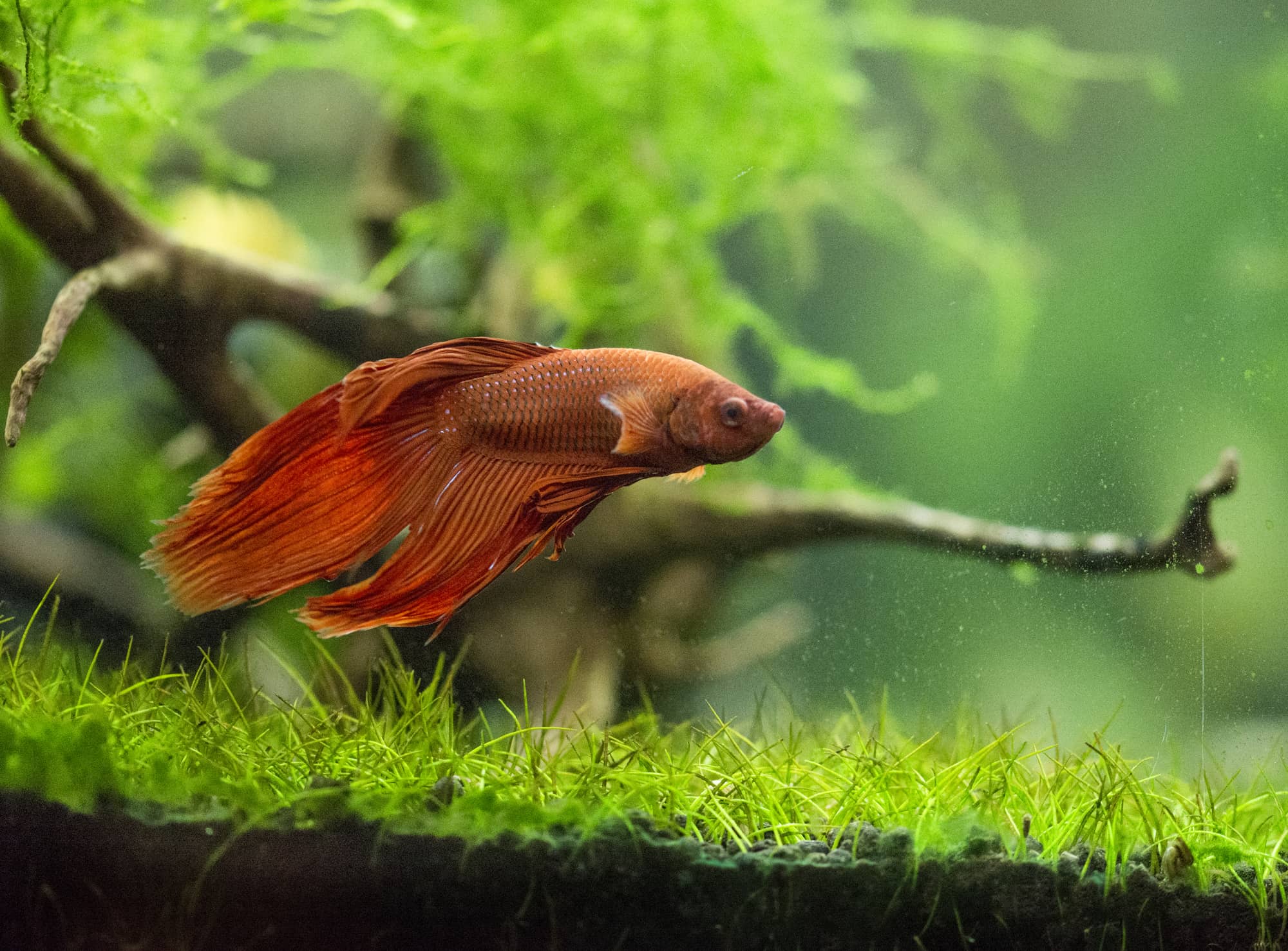
If there’s one fish suitable to end this list with, it’s the beautiful Betta splendens, widely known as the betta fish.
With so many breeders worldwide working hard to keep producing more and more interesting color variations of this popular fish species, there’s literally a betta for everyone: fish with bright colors, fish with extraordinary tail shapes, and even fish that look like dragons!
Betta fish make good beginner fish and can be kept in smaller tanks, like a 5-gallon single-specimen tank (18.9 L). To maintain the healthiest and brightest betta, you will need to provide plants and a variety of hiding places for them to retreat to and lean on when resting.
The downside of bettas is that they’re not good community fish, which only makes them an option if you’re looking to set up a single-species tank or choose from a limited number of tank mates.
There are many misconceptions about betta care out there, so be sure to look at a care sheet before impulsively falling for those fantastic colors.
If you’re interested in keeping bettas but not too fond of the artificially-bred Betta splendens, there are also some wild species to choose from that feature very bright colors as well.
The red and blue Betta imbellis or bright red Betta brownorum might just be your thing! You can find a more extensive list of wild Bettas here.
Conclusion
It’s commonly believed that the most colorful fish available for aquariums are only saltwater species. However, you don’t need to set up a full reef tank to have every color imaginable in your home aquarium!
There is a wide variety of freshwater fish to choose from that can fit in almost any tank size, including larger fish, smaller, active fish, shy fish, and fish of all shapes and sizes. You just need to find what’s right for your system.
If you have any more suggestions for colorful fish or want to share your experience with any of the fish on this list, don’t hesitate to leave a comment below.

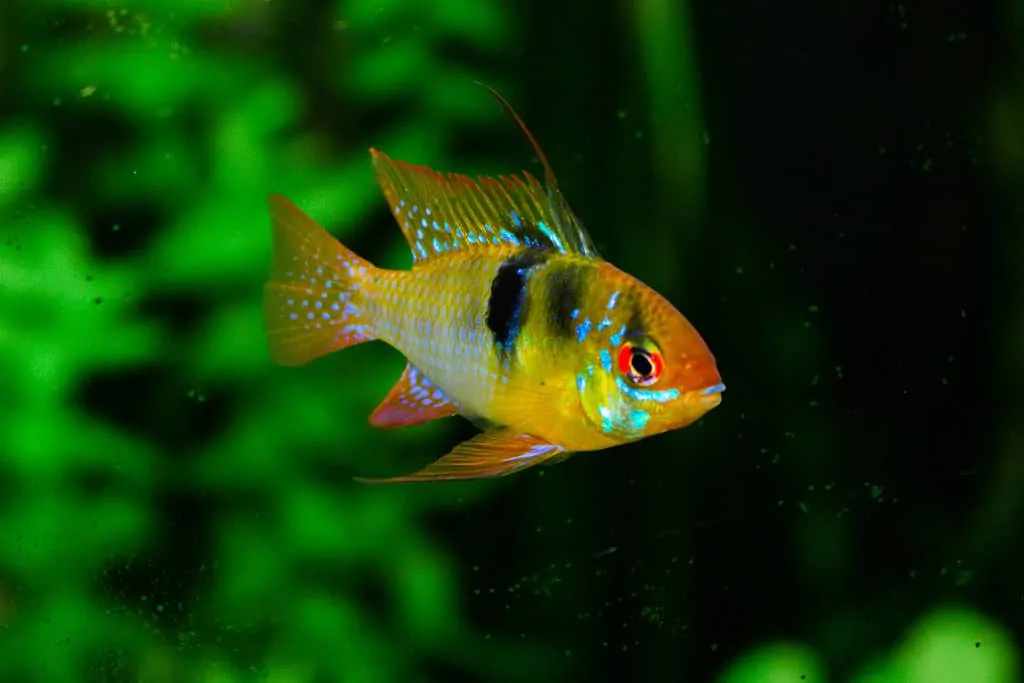

Hello! Your article is good. But I think, you should add Lion Fish in your article. That fish is very pretty too.
Hi!
If you’re talking about lionfish (Pterois sp.), then they’re not freshwater fish! Lionfish live in the warm waters of the ocean all around the world, and have become highly invasive in most areas; because of this, some hobbyists are even against supporting their commercialization in the aquarium trade.
If you’re talking about the freshwater lionfish (Batrachomoeus trispinosus), also referred to as the three-spined frogfish, then I wouldn’t categorize them as being exactly colorful and they’re actually not entirely freshwater either!
This was great as far as tropical species go, but I believe that our native small fishes can be as outstanding in color, and as easy or easier to maintain.
Gregg